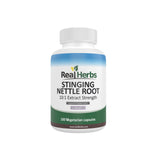Stinging Nettle Root in Traditional Culinary Practices: Beyond Tea
Introduction
Stinging nettle root, long revered for its medicinal properties in traditional herbal practices, is making a culinary comeback. While often associated with soothing teas, the versatility of stinging nettle extends far beyond the teacup. In this exploration, we delve into the culinary applications of stinging nettle root, unlocking its potential to enhance a variety of dishes and provide a unique nutritional boost.
Nutritional Profile
Before we venture into the culinary realm, it's crucial to understand the nutritional powerhouse that is stinging nettle root. Packed with an array of essential nutrients, this unassuming herb has earned its place not just in traditional medicine but also in the kitchen.
Vitamins and Minerals
Stinging nettle root boasts an impressive nutritional profile, featuring vitamins A, C, and K, as well as an abundance of minerals such as iron, magnesium, and calcium. These nutrients contribute not only to the herb's reputed medicinal benefits but also make it a valuable addition to a well-rounded diet.
Phytochemicals and Antioxidants
Beyond the standard vitamins and minerals, stinging nettle root is rich in phytochemicals and antioxidants. These compounds play a vital role in combating oxidative stress and inflammation within the body. Studies suggest that the unique combination of these bioactive compounds may contribute to the herb's anti-inflammatory and immune-boosting properties.
Protein Content
Surprisingly, stinging nettle root contains a notable amount of protein, making it an attractive option for individuals seeking plant-based protein sources. The protein content, coupled with its broad nutritional spectrum, positions stinging nettle root as a wholesome ingredient for those looking to diversify their dietary protein intake.
Traditional Medicinal Uses
Stinging nettle root has deep roots in traditional medicine, with its applications ranging from alleviating joint pain to promoting general wellness. Historically, it has been used to address conditions such as arthritis, allergies, and even as a tonic for overall health. While these traditional uses remain relevant, our focus here is on expanding its role into the realm of culinary practices.
Beyond Tea: Culinary Applications
4.1 Cooking Methods:
Incorporating stinging nettle root into your culinary repertoire requires a bit of know-how. Before diving into recipes, understanding the various cooking methods is essential. Cooking effectively neutralizes the stinging hairs, rendering the herb safe and palatable.
Steaming: A gentle method that retains the nutritional integrity of stinging nettle root. Steamed nettles can be used in salads, omelets, or as a standalone side dish.
Sautéing: Quick and versatile, sautéing stinging nettle root with garlic and olive oil imparts a delicious flavor. Use it as a base for pasta sauces, stir-fries, or as a topping for grilled proteins.
4.2 Recipes:
Let's bring stinging nettle root to life in the kitchen with a couple of easy-to-follow recipes.
Nettle and Potato Soup:
Ingredients: Stinging nettle leaves, potatoes, onions, garlic, vegetable broth, salt, pepper, and a touch of cream.
Instructions: Sauté onions and garlic, add diced potatoes and vegetable broth. Once potatoes are tender, add stinging nettle leaves and simmer. Finish with a splash of cream, salt, and pepper.
Nettle Pesto:
Ingredients: Stinging nettle leaves, pine nuts, garlic, Parmesan cheese, olive oil, salt, and lemon juice.
Instructions: Blanche stinging nettle leaves, then blend with pine nuts, garlic, and Parmesan. Gradually add olive oil until a smooth consistency is achieved. Season with salt and a squeeze of lemon juice.
Potential Health Benefits
Beyond its culinary appeal, stinging nettle root offers a spectrum of potential health benefits. Studies suggest that its anti-inflammatory properties may aid in managing conditions like arthritis, while its high vitamin and mineral content contribute to overall well-being. However, it's important to note that individual responses may vary, and consultation with a healthcare professional is advisable.
Safety Precautions
While stinging nettle root is generally safe when consumed in moderation, it's essential to be aware of potential allergies and take necessary precautions.
-
Handling: When working with fresh stinging nettle, wear gloves to avoid contact with the stinging hairs. Cooking or drying the herb eliminates the sting.
-
Allergies: Individuals with known allergies to plants in the Urticaceae family (which includes nettle) should exercise caution. It's advisable to start with small amounts to gauge individual tolerance.
-
Consultation: As with any dietary addition, especially if you have pre-existing health conditions or are on medication, consult with a healthcare professional before incorporating stinging nettle into your diet.
Where to Find and Harvest
Locating stinging nettle may be as simple as exploring local farmers' markets or health food stores. If you're interested in harvesting it yourself, consider the following:
-
Ethical Harvesting: If foraging in the wild, practice ethical harvesting by ensuring the sustainability of the plant population. Only harvest a small percentage of a given area, allowing the plant to regenerate.
-
Reputable Sources: When purchasing, choose reputable suppliers to ensure the quality and purity of the stinging nettle root. This guarantees that you are getting the full spectrum of nutritional benefits without contaminants.
Conclusion
In the realm of culinary exploration, stinging nettle root emerges as a hidden gem, offering not only a unique flavor profile but also a myriad of potential health benefits. From soups to pestos, this once-overlooked herb has the power to elevate your culinary creations while contributing to your overall well-being.












